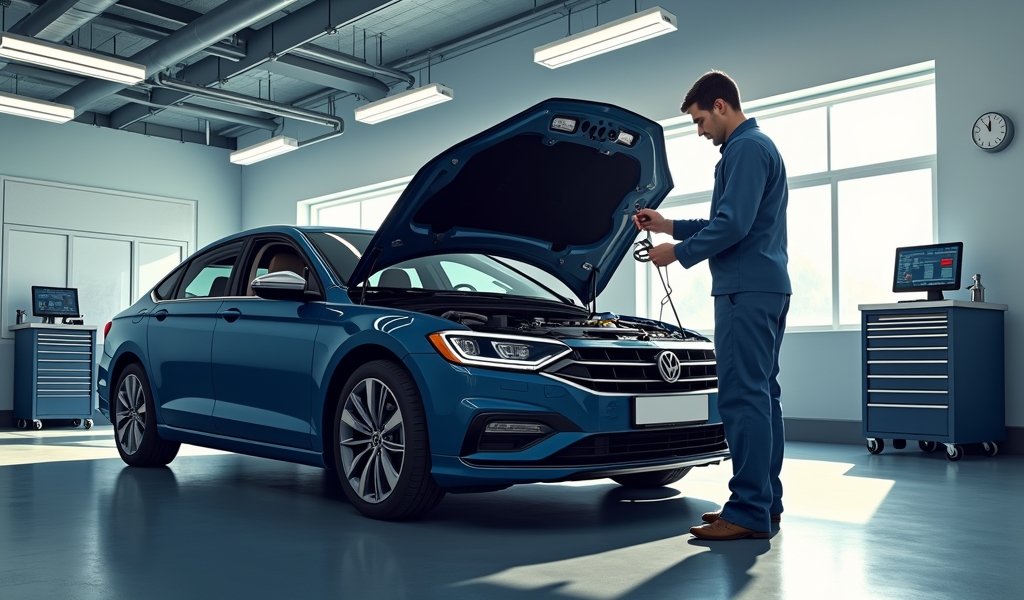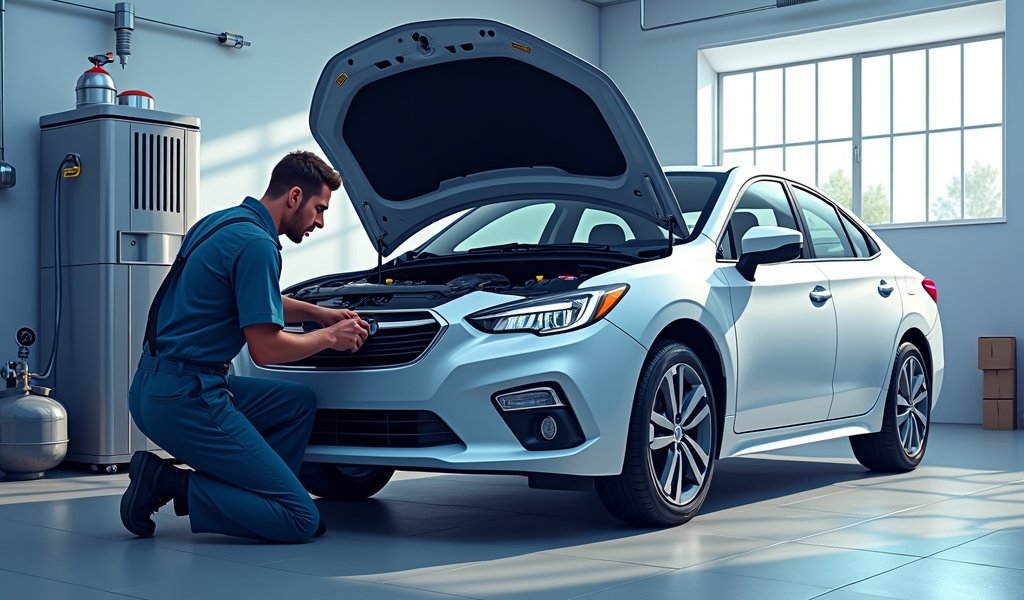Overview
This article outlines five essential car AC repairs: refrigerant recharge, compressor replacement, condenser repair, electrical system repairs, and cabin air filter replacement, while explaining when to seek professional help versus DIY solutions. It provides diagnostic signs for AC problems, preventative maintenance tips, and cost expectations for repairs, emphasizing that regular maintenance can prevent major system failures.
Table of Contents
- Understanding Car AC Systems
- Signs Your AC Needs Repair
- Essential Fix #1: Refrigerant Recharge
- Essential Fix #2: Compressor Replacement
- Essential Fix #3: Condenser Repair or Replacement
- Essential Fix #4: Electrical System Repairs
- Essential Fix #5: Cabin Air Filter Replacement
- DIY vs. Professional Repair
- Preventative Maintenance Tips
- Conclusion
- Frequently Asked Questions
Understanding Car AC Systems
There’s nothing worse than turning your car AC on during a scorching summer day only to feel warm air blowing in your face. I’ve seen countless drivers pull into our shop with sweat-drenched shirts and that unmistakable look of desperation that comes from driving without proper cooling.
Your vehicle’s air conditioning system isn’t just a luxury—it’s essential for comfortable and safe driving during hot weather. As a certified automotive technician with over 15 years of experience, I can tell you that understanding how your AC works is the first step toward keeping it running smoothly.
At its core, your car’s AC system operates on a simple principle: it removes heat and humidity from inside your vehicle and transfers it outside. The system consists of five main components:
- Compressor: The heart of the system that pressurizes refrigerant
- Condenser: Transforms hot gas refrigerant into liquid form
- Expansion valve/orifice tube: Controls refrigerant flow into the evaporator
- Evaporator: Absorbs heat from cabin air
- Receiver/dryer: Removes moisture from the refrigerant
When any of these components fails, your comfortable drive can quickly turn into a sweltering ordeal. Let’s look at the warning signs that indicate your AC system needs attention.
Signs Your AC Needs Repair
Your car will usually give you plenty of warning before the AC system fails completely. Knowing these indicators can save you from unexpected discomfort and potentially costly repairs down the road.
The most obvious sign is insufficient cooling. If you’re setting your AC to maximum and still feeling like you’re in a sauna, something’s definitely wrong. This isn’t normal, regardless of how hot it is outside.
Unusual noises when you turn on the AC are another red flag. A healthy system should run relatively quietly. Squealing, grinding, or rattling sounds often indicate problems with the compressor or its clutch assembly.
Have you noticed moisture or water pooling inside your car or an unpleasant moldy smell when you turn on the AC? This could indicate a clogged drain tube or mold growth in the evaporator—both issues that require prompt attention.
Weak airflow, even at the highest fan settings, typically points to problems with the blower motor, a clogged cabin filter, or obstructions in your car’s ventilation system.
If your AC cycles on and off rapidly or doesn’t engage at all, you’re likely dealing with an electrical issue or low refrigerant levels. Either way, it’s time to consider a professional car AC repair service.

Essential Fix #1: Refrigerant Recharge
Low refrigerant is the most common cause of AC problems I see in my shop. Unlike engine oil, refrigerant doesn’t get “used up” during normal operation. If your system is low, it means you have a leak somewhere.
The refrigerant (commonly R-134a or the newer R-1234yf) circulates through your AC system, absorbing heat from inside your car and releasing it outside. When levels drop, cooling performance suffers dramatically.
Signs you need a refrigerant recharge include:
- AC blows cool but not cold air
- Cooling works intermittently
- System takes longer than normal to cool your car
A professional recharge isn’t just about adding more refrigerant. We first recover any remaining refrigerant, vacuum test the system for leaks, repair any leaks we find, and then recharge with precisely the right amount according to manufacturer specifications.
This is definitely not a DIY job. Refrigerants are regulated by the EPA due to their environmental impact, and handling them requires certification and specialized equipment. Those “quick recharge” cans at auto parts stores often do more harm than good, potentially introducing air and moisture that can damage your system.
A proper recharge typically costs between $150-300 depending on your vehicle and refrigerant type. The newer R-1234yf refrigerant is significantly more expensive but has less environmental impact.
If your system needs frequent recharges, you likely have a significant leak that should be addressed. Professional technicians use UV dye and electronic leak detectors to pinpoint even the smallest leaks in hard-to-reach areas.
Essential Fix #2: Compressor Replacement
The compressor is your AC system’s workhorse. It pressurizes refrigerant and keeps it flowing through the system. When it fails, you’ll know it—usually with a bang (sometimes literally).
In my experience, compressors typically fail for one of three reasons: natural wear and tear after 100,000+ miles, lack of use during winter months (which dries out seals), or contamination in the AC system.
Warning signs of impending compressor failure include:
- Loud grinding or squealing when the AC runs
- Compressor clutch not engaging (visible from the front of the car)
- AC working intermittently
- Refrigerant leaks near the front of the engine
Replacing a compressor is complex work. The entire system must be evacuated, and often additional components like the receiver/dryer need replacement simultaneously to prevent contamination from damaging your new compressor.
Expect to pay between $500-1,200 for a complete compressor replacement job, depending on your vehicle make and model. European luxury cars typically land on the higher end of that range due to parts costs and labor complexity.
Here’s a pro tip: run your AC for at least 10 minutes every month, even in winter. This keeps the compressor seals lubricated and extends component life significantly. Many modern cars do this automatically, but older vehicles benefit from this simple maintenance habit.
Essential Fix #3: Condenser Repair or Replacement
Think of your condenser as the radiator for your AC system. It sits at the front of your car, usually in front of your engine’s radiator, where it can release heat from the refrigerant into the passing air.
Due to this front-line position, condensers frequently suffer damage from road debris, stones, and even minor fender benders. Over time, the thin aluminum fins can also corrode, especially in areas where road salt is used.
You might need condenser service if:
- Your AC cools initially but quickly loses cooling power
- You notice refrigerant leaks at the front of your vehicle
- The front of your condenser shows visible damage or bent fins
Minor condenser issues can sometimes be addressed without full replacement. Specialized fin combs can straighten bent fins, improving airflow. Small leaks in accessible areas might be repairable with specialized epoxies or brazing.
However, when damage is extensive, replacement is the only reliable solution. A condenser replacement typically costs between $400-800 including parts, labor, and system recharge. The good news? Modern condensers are often more efficient than the ones installed when your car was built.
Preventative maintenance for your condenser is straightforward: keep it clean. Periodically rinse it gently (with the engine off) to remove bugs, leaves, and debris that can impede airflow. When having other front-end work done, ask your mechanic to check the condenser condition and clean it if necessary.

Essential Fix #4: Electrical System Repairs
Modern automotive AC systems rely heavily on electronics, and electrical issues are some of the trickiest to diagnose. Blown fuses, faulty relays, malfunctioning pressure switches, and damaged wiring can all prevent your AC from working properly.
The challenging part? Electrical problems often create intermittent issues that come and go unpredictably. You might find your AC works fine in the morning but quits by afternoon, leaving you wondering if you imagined the problem.
Common electrical issues include:
- Blown AC fuses (usually 10-30 amp)
- Faulty AC relays
- Defective pressure switches
- Damaged wiring (often from rodents or previous repairs)
- Malfunctioning climate control modules
The good news? Electrical repairs are often less expensive than mechanical ones. A fuse might cost you just a dollar, while a relay typically runs under $20. Even complex components like pressure switches usually fall in the $50-150 range.
Some basic electrical troubleshooting falls within DIY territory. Most owner’s manuals show fuse box locations, and replacing a fuse is no harder than changing a light bulb. But for mysterious electrical gremlins, professional diagnosis with specialized equipment is usually the most efficient path.
At our shop, we use digital multimeters, logic probes, and scan tools to communicate with your car’s climate control system. This allows us to pinpoint electrical failures without the guesswork that leads to unnecessary parts replacement.
Essential Fix #5: Cabin Air Filter Replacement
The cabin air filter is the unsung hero of your AC system. It’s also the maintenance item most often overlooked by drivers—until weak airflow or funky smells make it impossible to ignore.
This filter traps dust, pollen, mold spores, and other airborne particles before they can enter your car’s ventilation system. Over time, it gradually clogs, restricting airflow and forcing your blower motor to work harder.
You should replace your cabin air filter if:
- Airflow from your vents seems weaker than normal
- You notice musty or moldy odors from the AC
- You haven’t replaced it in the past 15,000-30,000 miles
- You regularly drive in dusty conditions or heavy traffic
The good news? This is one of the easiest and most affordable AC-related repairs. Most cabin filters cost between $15-50, and many can be replaced without tools in under 15 minutes.
On most vehicles, the cabin filter is located either behind the glove box, under the dashboard, or under the hood near the windshield wipers. Your owner’s manual will show the exact location and replacement procedure.
For the ultimate cabin air quality, consider upgrading to a carbon-activated filter. These premium options not only trap particles but also absorb odors and harmful gases—perfect if you commute through areas with heavy traffic or industrial emissions.
I recommend setting a reminder to check your cabin filter every spring, just before heavy AC season begins. This simple habit dramatically improves system performance and prevents that embarrassing moment when passengers comment on strange smells coming from your vents.
DIY vs. Professional Repair
As a mechanic, I’m often asked what AC repairs are DIY-friendly and which ones require professional help. The honest answer? It depends on your comfort level, tools, and the specific issue.
Tasks that most DIY-inclined car owners can handle include:
- Cabin air filter replacement
- Basic fuse checks and replacement
- Cleaning debris from around the condenser
- Visual inspections for obvious leaks or damage
Tasks that should be left to professionals:
- Any work involving refrigerant handling
- Compressor replacement
- Condenser replacement or repair
- Electrical system diagnostics beyond basic fuse checks
- Evaporator core replacement (requires dashboard removal on most vehicles)
The main reason for professional AC service isn’t just complexity—it’s also environmental responsibility. Refrigerants must be properly recovered and recycled, not released into the atmosphere where they contribute to ozone depletion and global warming. Professional shops have the equipment to capture refrigerant during repairs.
When choosing a car repair shop, look for ASE certification and specialized HVAC training. Don’t be afraid to ask questions about their diagnostic process and warranty policies before authorizing work.
Preventative Maintenance Tips
An ounce of prevention is worth a pound of cure—especially when it comes to AC systems. Here are my top tips for keeping your car’s cooling system in peak condition:
- Run the AC for at least 10 minutes weekly, even during cooler months
- Set your AC to “recirculate” in extreme heat for maximum efficiency
- Replace your cabin air filter annually or every 15,000-30,000 miles
- Keep the condenser clean and free of debris
- Address minor AC performance issues before they become major failures
- Have your AC system professionally inspected every 2 years
During routine maintenance visits, ask your mechanic to perform a visual inspection of accessible AC components. Early detection of small problems like minor leaks or fraying belts can prevent system failure when you need cooling the most.
If you notice any changes in AC performance—even subtle ones like slightly reduced cooling or new noises—don’t wait for complete failure. Early diagnosis often means simpler, less expensive repairs.
According to research from the Car Care Council, properly maintained AC systems not only provide better comfort but can also improve fuel economy by reducing the need to drive with windows down, which creates aerodynamic drag.
Conclusion
Your car’s air conditioning system is more than a luxury—it’s an essential component that affects comfort, safety, and even fuel efficiency. Understanding these five essential repairs gives you the knowledge to address problems promptly and make informed decisions about maintenance.
Whether you’re tackling simple maintenance like filter replacement yourself or seeking professional help for complex repairs, staying proactive about your AC system pays dividends in comfort and reliability.
Remember that modern vehicles have increasingly sophisticated climate control systems that integrate with other vehicle systems. This complexity means that professional diagnosis is often the most efficient path to resolving issues, even for mechanically-inclined owners.
At the end of the day, your car’s AC should be invisible when working properly—silently creating a comfortable environment that lets you focus on the road ahead. With proper maintenance and timely repairs, you can ensure that cool comfort remains just a button-press away, no matter how hot it gets outside.
And if you’re ever unsure about your AC system’s performance or need professional assistance, don’t hesitate to reach out to certified automotive technicians who specialize in climate control systems. Your comfort behind the wheel is worth the investment.
Frequently Asked Questions
How much does car AC repair typically cost?
Car AC repair costs range from $100-1,200 depending on the specific issue. Minor repairs like refrigerant recharge or electrical fixes fall on the lower end, while major component replacements like compressors or evaporators cost significantly more.
How often should car AC systems be serviced?
Most manufacturers recommend a professional AC system check every two years. However, cabin air filters should be replaced annually or every 15,000-30,000 miles, depending on your driving conditions.
Why does my car AC smell bad when I turn it on?
Unpleasant odors usually indicate mold growth in the evaporator or a clogged cabin filter. The moisture that naturally condenses in the system creates a perfect environment for microorganisms when the car sits unused.
Can I recharge my car’s AC system myself?
While DIY recharge kits are available, professional service is strongly recommended. Improper recharging can introduce air and moisture into the system, causing damage to expensive components and potentially releasing harmful refrigerants into the atmosphere.
Why does my car AC blow cold then warm?
Cycling between cold and warm air typically indicates low refrigerant levels, a failing compressor clutch, or a clogged expansion valve. This cycling behavior is your system’s way of preventing component damage when it can’t maintain proper pressure.

